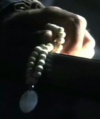This article discusses the Twelve Colonies of the Re-imagined Series. See The Twelve Colonies of Man for information on the Colonies of the Original Series.
|
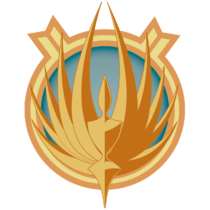
The Twelve Colonies of Kobol are twelve distinct worlds, located in a remote part of our Galaxy. For 2,000 years they were home to the descendants of humans participating in the exodus of Kobol.[1] For most of the two millennia that these worlds were inhabited, the Twelve Colonies consisted of multiple sovereign states, but during the final fifty-two years leading up to the Fall of the Twelve Colonies, all twelve comprised a single state known as the United Colonies of Kobol (TRS: "Colonial Day")[2].
After the settlement, the colonies slowly began to prosper and eventually gave birth to a race of cybernetic lifeforms, known as Cylons. Only a few years after their creation, the Cylons raged a devastating war on their creators' home planets, which ultimately led to the Fall of the Twelve Colonies. Wasted and in ruins, the once prosperous homeworlds of humanity were finally abandoned by both humans and Cylons.
| Part of the series on | ||||||||||||
|
| ||||||||||||
Star System
edit- Note: A portion of the information listed below is taken from the official, "quasi-canon" Battlestar Galactica Map of the 12 Colonies [3].
The Twelve Colonies are situated within the star system Cyrannus, located some 2,000 light years from Kobol, where humanity presumedly first evolved. All in all, Cyrannus is a vast and complex system, comprised of four [4] stars: Helios Alpha, Helios Beta, Helios Gamma, and Helios Delta. Each star is orbited by its own family of planets and other astronomical bodies. The stars come together to form two binary systems (Alpha/Beta and Gamma/Delta). Both pairs of stars then orbit each other around a third, central barycenter every 546,892 years. Both binary systems are separated by 0.16 light years or 10,091 Stellar Units, shortened to SU (In this case, 1 SU being equal to the average distance between Helios Alpha and the barycenter of the Caprica-Gemenon binary, roughly 150 million km).
Helios Alpha
editHelios Alpha is a main sequence star of spectral class G2V and has a mass of 1.0, and was the first system settled by the Colonials after the exodus from Kobol, having first set foot on Gemenon. It and Helios Beta orbit a common barycenter maintaining a separation of 63 SU. Helios Alpha is more massive and is closer to the system's barycenter. [5] The pair complete an orbit once every 373 years.
- Planets and Other Astronomical Bodies
- Icarus - A small planet located close to the star. It has a molten surface which makes mining and exploration impossible.
- Picon - This colony has an inclined orbit.
- Caprica and Gemenon - These two colonies form a binary planet.
- Tauron - One of only three colonies to feature a moon, named Minos. It is the only moon with a ring, and home to several mining and scientific outposts.
- Erebos asteroid belt - This asteroid belt is rich in minerals, which were mined by Tauran prospectors for hundreds of years.
- Zeus - A gas giant located at the outer edge of the system. This gas giant is the largest planet in the four systems, with a diameter of 153,000 km at the equator. The planet has 74 moons, the largest of which are Nike and Hebe. Constant upper atmosphere lightning creates an aurora effect that can be seen with the naked eye.
- Persephone - Classified as a dwarf planet, Persephone is the outermost planet in the system and features an inclined and eccentric orbit. Colonial scientists believe this planet could be an escaped moon of Zeus.
This system is unique in the fact that Caprica and Gemenon share an orbit around a common barycenter. According to the Colonial map, the planets orbit each other once every 28.2 days, and are separated by a distance of 493,000 km. Based on these numbers, Kepler's Third Law tells us that the combined mass of these colonies is about twice that of Earth.
Helios Beta
editHelios Beta is a main sequence star of spectral class K1V and has a mass of 0.79. It was the second system settled by the Colonials after the exodus from Kobol. It and Helios Alpha orbit a common barycenter maintaining a separation of 63 SU. Helios Beta is less massive and is farther from the system's barycenter. [5] The pair complete an orbit once every 373 years.
- Planets and Other Astronomical Bodies
- Troy - A small, metal-rich planet, mined extensively by Virgon and Leonis since the founding of those two colonies.
- Leonis - The largest inhabited planet of the Twelve Colonies.
- Pallas - A small world with an inclined orbit once believed to hold a life sustaining atmosphere. It is no longer tectonically active. However, the Colonials have set up several small colonies and a military research station on the planet. Efforts to kobolform the planet have failed.
- Ouranos asteroid belt - This dense asteroid belt separates long-time rivals Leonis and Virgon, and has been a source of minerals for both colonies.
- Virgon - One of only three colonies to feature a moon, named Hibernia, and the only naturally habitable moon in the 12 Colonies. It was settled several centuries ago by the Celtans, an ethnic group opposed to Virgon rule.
- Hera - A gas giant, approximately 75,000 km in diameter, and the third largest planet in the Cyrannus system. It has 29 moons, the largest of which are Iris and Eubora.
Helios Gamma
editHelios Gamma is a main sequence star of spectral class G9V and has a mass of 0.89. It was presumably the third system settled by the Colonials. It and Helios Delta orbit a common barycenter maintaining a separation of 70 SU. Helios Gamma is more massive and is closer to the system's barycenter. [6] It completes an orbit once every 456 years.
- Planets and Other Astronomical Bodies
- Thanatos - This planet, named after the god of death, has a corrosive 'sulphur' dioxide atmosphere and is tidally locked to its star.
- Acheron asteroid belt - A broad asteroid belt, named after Sagittaron's largest river.
- Libran - Features two small moons, Herse and Pandrossos, which are thought to be captured asteroids. The moons orbit so close to each other, they periodically swap positions.
- Scorpia - Home to the Scorpion Fleet Shipyards. The planet features a half ring, thought to be a moon that broke apart nearly 100,000 years ago.
- Sagittaron - A barren, mountainous world.
- Ophion - A frigid gas giant with a diameter of 51,000 km, and an inclined orbit. The planet has 14 moons, all smaller than 10 km in diameter. Studies on the planet have Colonial scientists thinking that Ragnar was originally a member of the Helios Gamma system, while Ophion was not. Scientists think that Ophion was a rogue planet that passed close to Ragnar and was caught by the star, pushing Ragnar into its current orbit around the entire Gamma/Delta system.
Helios Delta
editHelios Delta is a reddish main sequence star of spectral class K2V and has a mass of 0.74. It was the last of the four systems to be settled by the Colonials. It and Helios Gamma orbit a common barycenter maintaining a separation of 70 SU. Helios Delta is less massive and is farther from the system's barycenter. [6] It completes an orbit once every 456 years.
- Planets and Other Astronomical Bodies
- Phoebe - A small world with a high surface temperature and thin atmosphere.
- Styx - A planet with a dense, reducing atmosphere of carbon dioxide and sulfides.
- Aeolus asteroid belt - This asteroid belt features gaps, likely caused by tidal influences with Hestia and its two orbital companions.
- Aerilon, Hestia, and Canceron - These planets share the same orbit.
- Hestia - The smallest gas giant in the Cyrannus star system, Hestia only has a diameter of 47,000 km. It has 17 moons, the largest of which, Kronos and Rhea, share the same orbit.
- Aquaria - An arctic world, with the most inclined orbit of all the Twelve Colonies.
This system is unique in the fact that Aerilon, Hestia, and Canceron share the same orbit. The two colonies are positioned at Hestia's Lagrangian points, meaning that the gravitational pull of Helios Delta and Hestia are balanced, allowing two smaller bodies (Aerilon and Canceron) to share the same orbit in a "fixed" position, maintaining the same distance apart at all times. Aerilon sits at the (leading) L4 point, and Canceron at the (trailing) L5 point.
- Ragnar - A gas giant with a diameter of 138,000 km, orbits the entire Helios Gamma and Delta system in a 899.75 year period. It is about 110 SU away from the central barycenter. The Colonials use the planet as host to Ragnar Anchorage, an orbital refueling station and naval armory that distills hydrocarbons from the planet's upper atmosphere. It has one moon, Sigurd. During the Fall of the Colonies, Ragnar was used as cover by the battlestar Galactica, and later her fleet, after escaping the destruction of Caprica. It would be the last world of the Cyrannian system that most of the surviving Colonials would lay eyes on. Hours after arriving, Galactica took the gathered fleet, and fled the system, never to return.
Notes
edit- The fact that the Colonies are located within one system originates from a blog entry by Ronald D. Moore.
- Jane Espenson revealed on Twitter that the Colonies are within a star cluster and share some orbits. The latter fact was finally shown to be true in the TV version of the series premiere of Caprica.
- The configuration of the Twelve Colonies was inspired by the real world star system Epsilon Lyrae, a famous "double-double" star system located ~162 light-years away from Earth in the constellation of Lyra. [7]
- Before the semi-canonical figure mentioned on the map, the original Miniseries script stated a pre-Fall population of about 12 billion. The webisodes "The Resistance" stated the death of 20 billion people caused by the Cylons.
- Serge's twitter mentions that the exodus from Kobol is believed to be true by the inhabitants of the Twelve Colonies and it was from them that animals such as cats as well as dogs came to the Colonies. Furthermore, the twelve planets are populated with a few other worlds in the star cluster, with the settled colonies already possessing some animal as well as plant life. Furthermore, Serge states that not all the colonies are democracies, but rather each has their own style of government. (Serge's Twitter)
History
edit- Main article: History of the Twelve Colonies
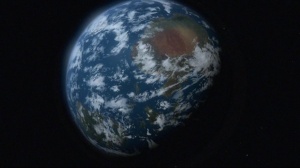
About 2,000 years prior to the Fall of the Twelve Colonies, the last twelve tribes of Kobol left their planet[8] over conflicts with their gods, as well as some sort of calamity (TRS: "Kobol's Last Gleaming, Part I").
The tribes settled on twelve worlds some distance away (TRS: "Kobol's Last Gleaming, Part I"). The tribes' namesakes and icons originally corresponded to the twelve signs of the ancient tribes, although these names drifted over time (TRS: "Home, Part II").[9]
The early Colonies lived (and fought) more as sovereign nations. Some (particularly Caprica) prospered, while others (such as Sagittaron and Aerilon) were often considered lessers. For labor forces as well as wars fought among each other, humanity created the Cylons. When these early models rebelled, the Colonies unified their governments under the Articles of Colonization at some point during the Cylon War into a federal republic known as the Twelve Colonies of Kobol.
The official symbol of the Twelve Colonies was the Colonial seal. The nation also had a distinctive anthem.
Downfall
edit- Main article: Fall of the Twelve Colonies
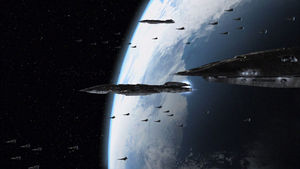
40 years after the end of the devastating war, the Cylons return and sow destruction among the worlds of their creators (TRS: "Miniseries" and "The Plan"). For some time the Twelve Colonies remain occupied by Cylon forces and a small group of human survivors. After nine months, humanity and the Cylons leave the Cyrannus system forever (TRS: "Lay Down Your Burdens, Part II").
Out of all Colonial inhabitants, only about 55,000 survive the first days of the holocaust. Most of them leave the Colonies behind in two small fugitive fleets. The fleet of the battlestar Galactica eventually encounters both Kobol, as well as the original Thirteenth Colony Earth. Some time after that, and after the destruction of the the Cylon home world, they settle on a beautiful, rich world, leaving behind the baggage of their Colonial heritage. (TRS: "Miniseries", "Razor" and "Daybreak, Part II")
Fate
editThe ultimate fate of the Twelve Colonies 150,000 years after The Fall is unknown. Presumably, after several hundred years, their climates and surfaces would degrade until they resemble the original Earth.
It can be presumed that by present-day radiation levels would have lowered to a point where life would be allowed to flourish once again. But few, if any, traces would remain of the human civilizations that once thrived upon them, excluding remains in space, such as the remnants of Scorpion Fleet Shipyards or Ragnar Anchorage.
Aerilon
edit- Main article: Aerilon

Ancient Name: Aries
Alternative Name: Aerelon
Population: 1.2 billion
Patron God: Demeter
Capital: Gaoth
Major Cities: Gaoth, Promethea
Attractions: University of Aerilon, Promethea A & M
Pyramid Teams: Aerilon Threshers, Promethea Golden Horns
Aerilon was primarily an agricultural world. It was considered to be the "food basket" of the Twelve Colonies and ranked among its poorest members (TRS: "Dirty Hands"). The planet shares an orbit with the gas giant Hestia and Canceron, sitting in Hestia's leading (L4) libratian point in the Helios Delta system.
About all of the planet's landmasses are situated in the temperate zones, featuring open and rolling landscapes offering little variation in altitude. There are few inland waterways, and the shorelines consist mostly of rocky bluffs with only mangrove swamps breaking the monotony near the equator. To top it the planet offers hostile seas with no useful harbors at its coasts.
Aerilon has a mild climate and reliable seasons, with plentiful rain, so catch basins and wells are sufficiently filled and fresh water is readily available despite the lack of rivers and lakes.
Aquaria
edit- Main article: Aquaria

Ancient Name: Aquarius
Alternative Name: Aquarion
Population: 25,000
Patron God: Hermes
Capital: None
Major Cities: Heim
Attractions: Kyros Summerfest
Pyramid Teams: None
Aquaria, the outermost planet in the Helios Delta system, follows a highly inclined orbit around its sun, establishing an arctic climate on this world. The planet's summer lasts only a few pleasant weeks around the time of closest approach to Helios Delta.
The planet surface is about entirely covered by vast, frigid oceans, punctuated with violently erupting volcanoes breaking through the sea surface. Only one land mass, named Kyros, is large enough to sustain human habitation. Volcanoes occupy each end of this crescent-shaped continent, which consist mostly of volcanic tephra covered in moss and dotted by exotic native plantlife.
Most people live in Heim, a town at the centre of the island facing what would be the harbor if the seas weren't so frigid. Only a few people live outside the town, tending the infrastructure needed for survival, like windmills, hydroponics, and solar panels. Due to the lack of wood, most structures are made of tin or stone.
Canceron
edit
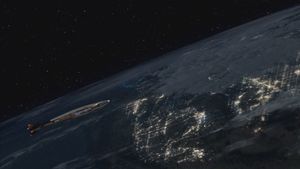
Ancient Name: Cancer
Population: 6.7 billion
Patron God: Hephaestus
Capital: Hades
Major Cities: Hades, Prommos, Mangala
Attractions: Prommos, Ruby Range, Kor Yaz Glacier
Pyramid Teams: Canceron Hydras, Hades Vice, Mangala Krill
Canceron is the most populous planet in the twelve worlds. It is located in the Helios Delta system, sharing its orbit with two other planets, one of them being Aerilon. The planet was well known for its beaches, such as those in Brachyura City (B.C.), and had at least one large coastal metropolis (TRS: "The Plan"). The capital was Hades.[10]
Prior to the First Cylon War, Canceron was a very overpopulated and poor colony. Canceron's major cities such as Hades and Mangala were known to have large slums. Its large population earned Canceron the nickname "The Largest Democracy" within the colonies, though some believed the government was nothing more than a corrupt oligarchy (The Caprican: "Canceron Wants a Fourth Pyramid Team" and "Just Wondering About That Military Roadblock Thing"). Those who hail from coastal cities, such as Brachyura City, were stereotyped as promiscuous, hedonistic "tanned airhead surfers" (The Caprican: "Playing the Field: Lonely Girl from B.C. needs our help & more!").
During the Cylon attack, Canceron is hit with at least three nuclear devices. One of the passenger liners within the fleet, Pyxis, is one of the last ships that escapes this world when the attack began. Aboard is the Number Six copy Shelly Godfrey (TRS: "The Plan").
Robin Wenutu is the Canceron delegate to the first Quorum of Twelve after the Fall (TRS: "Colonial Day").
Natives
edit
Caprica
edit- Main article: Caprica (RDM)


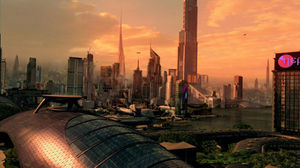

Ancient Name: Capricorn
Population: 4.9 billion
Patron God: Apollo
Official Language: Caprican
Capital: Caprica City
Major Cities: Caprica City, Delphi, Phoebus
Attractions: Delphi Museum of the Colonies, Atlas Arena, Caprica Interplanetary Spaceport, Graystone Industries, Apollo University, Pantheon Bridge, Ionian Islands, Orpheus Park
Pyramid Teams: Caprica City Buccaneers, Delphi Legion, Phoebus Suns
Caprica was a lush blue-green planet, covered by large oceans and continents. It shares its orbit with Gemenon around a common barycenter, and can often be seen in the skies above the Caprican landscape. Depending on its orbit, the Caprican night can almost be negated by intense planetshine from Gemenon, although not as bright as the Caprican sun, there is enough light reflected back to effectively turn night into day (TRS: You Can't Go Home Again, Litmus). Of curious note, Caprica features landmasses similar to a world the Colonials would eventually settle and come to call Earth.
Caprica was regarded as the center of Colonial civilization, even long before the First Cylon War. Graystone Industries was one of the Colonies' most influential technology developers and had a hand in creating the very first Cylons. Some 60 years before the Fall, Caprica was also plagued by religiously motivated terrorism (CAP: "Pilot"). After the war, the planet was once again the seat of politics, culture, art, science, learning and even the Colonial government. It was also one of the wealthiest colonies (TRS: "Epiphanies" and "Dirty Hands").
During the Cylon attack, Caprica and it's surrounding airspace, played host to numerous skirmishes, one of which would eventually determine the outcome of the war. Caprica herself, comes under heavy attack from Cylon forces right from the start. With numerous basestars jumping directly into orbit, they are quickly able to gain the upper hand. At least four battlestars, including the Yashuman and Valkyrie, are quickly dispatched, and numerous targets, including the once proud Caprica City, are annihilated from orbit by nuclear weapons (TRS: "Miniseries" and "The Plan"). The attacks leave the civilian shipping lanes in the vicinity of Caprica/Gemenon shut down, but the civilian ships are relatively ignored in the opening moments of the attack, in favor of military targets. This gives them time to gather and flee the area, picking up other survivors along the way. Eventually the fleet amasses over 100 ships of all kinds, both civilian and homeless military support craft. However, only 75 FTL capable ships are able to flee Caprican airspace, leaving the sub-lights, and their passengers, at the hands of the Cylons.
At the time of the attack, Galactica was positioned 3 hours away, and was not able to partake in the defense of its home planet. It wasn't long, however, before the Cylons located its position, and attempted to take it out. After being struck by a nuclear warhead, suffering major damage, and not having anything to shoot with, but still in one piece, Galactica had no choice but to retreat to the relative safety of the gas giant, Ragnar (TRS: "Miniseries"), leaving Caprica, and the remaining survivors, completely defenseless and on their own.
After the space-faring Colonials flee, Caprica is occupied by Cylon forces, attempting to undo the damage they've done, and colonize the planet themselves. They often clash with human survivors within the Colonies, and fight on this world for several weeks. The occupation and resistance both end roughly nine months after the attack and the planet is left for good (TRS: "33", "Resistance", "Lay Down Your Burdens, Part II" and "The Plan").
6,250 people from Caprica join the Laura Roslin faction over Kobol (TRS: "Home, Part I"). The overall Caprican survivor population, possibly significantly greater, is unknown (see analysis here). An attempted settlement by the survivors of the holocaust is named New Caprica in honor of the original colony (TRS: "Lay Down Your Burdens, Part II").
The first Quorum of Twelve delegate after the Fall is Gaius Baltar. Years later this spot is taken by Lee Adama, the last Quroum delegate from that colony before Delegate Adama establishes the Quorum of Ships' Captains in the wake of the mass-execution of the Quorum during Gaeta's Mutiny (TRS: "Islanded in a Stream of Stars").
Natives
edit- William, Tamara, Zak and Lee Adama
- Richard Adar, presumed as he was also the mayor of Caprica City at one point
- Daniel, Amanda and Zoe Graystone
- Lacy Rand and her family
- Laura, Cheryl and Sandra Roslin, as well as their parents
- Ben Stark and his mother, Natalie
- Kara, Socrata and (presumably) Dreilide Thrace
Notes
edit- Caprica was and continues to be the world most prominently depicted in the re-imagined series continuity. Until "Razor," none of the other eleven Colonies was verifiably depicted on screen.
- Serge's Twitter account states that Caprica had a number of unique lifeforms on its surface, though transplantation by early Colonists spread them to the other planets.
- Serge's Twitter account also notes that Caprica spends the most on Colonial defense in the years prior to the First Cylon War.
Gemenon
edit
Ancient Name: Gemini
Population: 2.8 billion
Patron God: Hera
Official Language: Old Gemenese
Major Cities: Oranu, Illumini
Attractions: Kobol Colleges, Illumini Pantheon, Gramada Mountains, Spatiu Gol Plateau, Pustiu Desert
Pyramid Teams: Gemenon Twins, Illumini Vipers
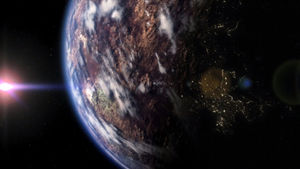
Gemenon was the first world colonized by the humans of Kobol. It shares its orbit around Helios Alpha with Caprica, completing an rotation once every 28.2 days. Its status as a twin planet gives it its name[12]. Its climate can vary wildly, featuring frozen plateaus, and searing deserts, which can make life difficult for its inhabitants.
It was one of the poorer colonies and its people, the Gemenese, were known for their religious fundamentalism (TRS: "Scattered" and "Dirty Hands").[13]
Before the First Cylon War, Gemenon was home to the Kobol Colleges (TRS: "Miniseries, Night 2") and a monotheistic cult called "The Soldiers of the One" (STO). Beginning in 58 BCH (42YR), the first U-87 Cyber Combat Units were sold on the black market to the STO, and would eventually lead into escalations that laid the groundwork for the genesis of the Cylons turning on their creators (CAP: "Pilot", "Blowback" and "Apotheosis"). Gemenon's second-largest city, Illumini, was built around a large Pantheon complex, composed of buildings intended to worship and celebrate every deity in the Sacred Scrolls.[14]
The Gemenese were known for their literal interpretations of the Scrolls (TRS: "Fragged"). Most of the population of Gemenon was apparently very strongly opposed to the federal laws legalizing abortion (TRS: "The Captain's Hand").
The planet also had either an old or disused language, known as Old Gemenese (TRS: "Razor").
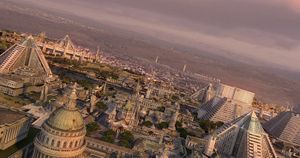
During the Cylon attack, Gemenon comes under heavy assault by Cylon air and ground forces, completely obliterating one city with a high-yield nuclear device, and causing extensive damage to another with conventional means. At least one ship, the Cybele, is able to escape the destruction of its port and occupying Cylon forces, and find Roslin's fleet (TRS: "The Plan").
Three months after the attacks, approximately 9,500 Gemenese break away from the main fleet, and join the Laura Roslin faction over Kobol (TRS: "Home, Part I"). The large and devoted Gemenese population continues to be an important political factor within the fugitive fleet (TRS: "The Captain's Hand").
Natives
edit- Adrien Bauer
- Jurgen Belzen and his family
- Rya Kibby
- Romo Lampkin
- Sarah Porter, former delegate to the Quorum of Twelve
- Corporal Venner
Notes
edit- If the word "Inviere" (meaning "Resurrection") is any indication, Old Gemenese was probably similar to the Romanian language of our Earth.
- According to Serge's Twitter account, Gemenon is the planet that shares its orbit with Caprica. This planet is seen at the beginning of the aired Caprica pilot, but is not clearly identified as such until Caprica's "The Heavens Will Rise" in a visual transition from Caprica to Gemenon.
- As an Easter Egg in The Plan, the building on the lower left of the screen is the same one where the Romulan Senate assembles in Star Trek Nemesis. A detailed picture of this building is available here.
Related Imagery
editLeonis
edit
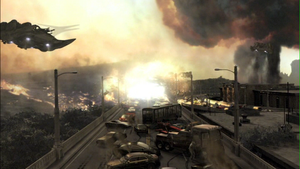
Ancient Name: Leo
Population: 2.6 billion
Patron God: Artemis
Official Language: Leonese
Capital: Luminere
Major Cities: Luminere, Hedon
Attractions: Royal Palace of Leonis, Hedon Grand Casino
Pyramid Teams: Leonis Wildcats, Hedon Suns
Leonis is the second planet in the Helios Beta system, and was geographically known for its open plains (TRS: "The Plan"). The planet itself has no axial tilt, which supports a mild and predictable climate. It was a major hub for both education and industry, and despite Colonial unification, it was able to maintain its own language and culture.
In the era prior to the First Cylon War circa YR42, it was known for its opulence in the form of the Hedon Grand Casino, which hosted a well-known event, Hedon Film Festival.
Leonis produced and exported a popular energy drink named Leonis Red pre-First Cylon War[14], as well as Leonis Estates Sparkling Wine that survives briefly after the Fall (TRS: "Flight of the Phoenix"). Hawryliw beer originates from the city of Vislovka (TRS: "Colonial Day").
During the aforesaid attack, Leonis is struck with at least one low-yield nuclear device, that was able to stun its residents and disable any means of escape. Those who survived the blast, are then seen being systematically eliminated by both ground and air forces (TRS: "The Plan"). It is unknown if any are collected and used in the Four's various farms.
Safiya Sanne is the Leonan representative on the first Quorum of Twelve after the Fall (TRS: "Colonial Day").
Libran
edit
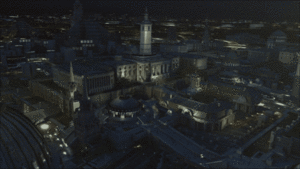
Ancient Name: Libra
Alternative Name: Libris
Population: 2.1 million
Patron God: Athena
Capital: None
Major Cities: Themis
Attractions: Supreme Hall of Justice, Themis Arena
Pyramid Teams: None
Libran was known for its courthouses and lawyers (TRS: "The Plan"), and was the home of the Inter-Colonial Court (CAP: "Gravedancing"). The planet had no official capital.[15]
A major city on Libran was called Themis which had a large, modern pyramid arena built sometime before the First Cylon War. Yet at this time Libran had no official pyramid team.[16]
After the Fall of the Twelve Colonies, Oswin Eriku is chosen to be this colony's representative to the Quorum of Twelve.
Zephyr, a passenger liner in the Fleet, is of Libran registry.[17]
Notes
edit- The Colony's actual name, Libran, was not heard on screen until "The Plan" but could already be seen on a name plate in "The Ties That Bind" and "A Disquiet Follows My Soul". Before that it was often called Libris in secondary publications.
- The city that is seen when Libran is mentioned in the "Caprica is burning" monologue in "The Plan," bears a striking resemblance to Tauron City, as seen in "Know Thy Enemy".
- Serge's twitter account says that the Libran court system served as a body through which trade disputes and legal matters were capable of being sorted amongst the colonies. He also states that it is a high earning colony but is not regarded as a desirable place to live, and he states that the planet is "largely a wildlife reserve".
Picon
edit
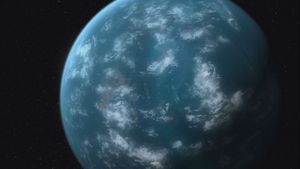
Ancient Name: Pisces
Population: 1.4 billion
Patron God: Poseidon
Capital: Queenstown
Major Cities: Perkinston, Queenstown, Pailyn
Attractions: Colonial Fleet Headquarters, Penrose Harbor
Pyramid Teams: Picon Panthers
Picon was a turquoise planet, containing 75% water, and famous for its harbors (TRS: "The Plan"). The capital city was Queenstown, which started as a relatively small fishing village.[18][19]
During the planet's off-season, most of the landscape became cold and rugged.[18] The planet was often used as a substitute for Caprica City in Caprican films and TV series.[14]
Pre-First Cylon War
editIn a monologue prior to an interview with Daniel Graystone circa YR42, Baxter Sarno notes that Picon demands Caprica apologize for "raising the ambient level of terror in the Colonies" in the aftermath of the Maglev 23 bombing. As part of the monologue's punchline, Sarno joked that that Caprica would agree only if Picon "apologies for being a prick." Sarno later notes that he makes fun of Picon because they are "barely a planet" (CAP: "Gravedancing" deleted scene).
Lethe beer is brewed at the unionized Ivana Vasak Brewery's branch in Picon Valley (CAP: "Gravedancing").
CSN offers a gold-color "traditional Picon engagement necklace" with dolphin symbology (CAP: "Retribution").
Post-Armistice
editAfter the unification of the Twelve Colonies Picon of the Colonial Fleet Headquarters (TRS: "Miniseries"). Picon was also the home of Picon Laboratories, located in Pailyn, Muritolan (TRS: "Faith").
The colony came under heavy attack during the early stages of the Cylon attack. One of the last ships to leave the planet was Rising Star, carrying many wounded people including an unconscious Ellen Tigh (TRS: "The Plan").
The destruction of Picon's Fleet Headquarters caused President Richard Adar to offer a complete and unconditional surrender to the Cylons. This offer was ignored by the invading forces (TRS: "Miniseries").
Natives
editPublications
editNotes
edit- Picon's destination as a substitute for Caprica in films and series is likely a reference to Canada, and particularly Vancouver, where both the Re-Imagined Series and Caprica were filmed.
- According to Serge's twitter account, Picon has the most efficient, cooperative and responsive democracy in the colonies.
- In one post, it's said that Picon offers tax incentives for production of TV programs on the planet though Caprica remains the leading producer of such shows.
Sagittaron
edit- Main article: Sagittaron

Ancient Name: Sagittarius
Alternative Name: Sagittarion
Population: 1.7 billion
Patron God: Zeus
Capital: Tawa
Attractions: Acheron River
Pyramid Teams: Sagittaron Archers
Sagittaron was one of the poorest worlds of the Twelve Colonies (TRS: "Bastille Day"). The capital of this planet was Tawa.[10]
The Sagittarons were traditionalists who practiced a different form of religion from the other Colonials. They distrusted modern medicine and were generally unsupportive of the military (TRS: "The Woman King").
The Planet endured centuries of exploitation at the hands of the other Colonies. Eventually, Tom Zarek led an organized series of terrorist acts against the established government there, many years before the Fall of the Colonies (TRS: "Bastille Day").
A few days after the Cylon attack, 5,251 people from this world reside within the Fleet (TRS: "33").
Natives
editNotes
edit- The colony's name was originally spelled as "Sagittarion" in the Miniseries, but this changed to Sagittaron when the regular series began.
Scorpia
edit
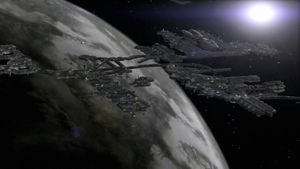
Ancient Name: Scorpio
Population: 450 million
Patron God: Dionysus
Capital: Celeste
Major Cities: Celeste, Argentum
Attractions: Argentum Bay, Guardian Mountains, Scorpia Shipyards
Pyramid Teams: Scorpia Stingers, Celeste Storms, Celeste Lightning, Argentum Bay Silverstars
Scorpia was known for its lush jungles and hot temperatures (TRS: "The Plan"). Scorpia's capital was Celeste.[10]
Before the First Cylon War one of the major leisure spots of the world was Argentum Bay, despite the colony's trashy reputation (The Caprican: "Argentum Bay: The Ultimate Vernal Break"). The Planet was also apparently well-known for its paragliding (TRS: "Razor") and its particular variant of ambrosia infamous for its potency and sulfur taste (CAP: "Know Thy Enemy").
After the Unification, Scorpia was home to the Scorpion Fleet Shipyards.
During the initial Cylon attack, Scorpia falls victim to numerous massive nuclear attacks, destroying much of the population. Cylon forces also focus on the orbiting ship yards, obliterating the structure, destroying numerous Battlestars and support ships, and causing another one to risk a blind jump in order to escape (TRS: "Razor" and "The Plan").
Eladio Puasha serves as the planet's delegate to the first Quorum of Twelve assembled after the Fall (TRS: "Colonial Day").
Notes
edit- In an LA Times article, Scorpia is described as having a "scorpion tail-like half-ring".
Tauron
edit- Main article: Tauron

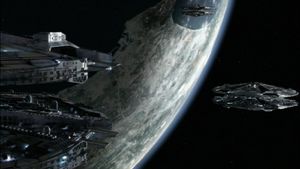
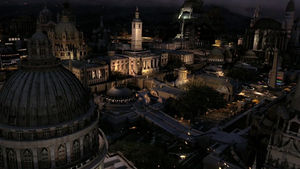

Ancient Name: Taurus
Population: 2.5 billion
Patron God: Ares
Official Language: Tauron
Capital: Hypatia
Major Cities: Hypatia, Tauron City (Minos)
Attractions: Minos, Olympia Hippadrome, Great Tauron Plains
Pyramid Teams: Olympia Stallions, Tauron Bulls
Tauron was a barren, arid planet that lacked any kind of flowers. However, it was well-known for its agriculture (CAP: "Pilot"). Its capital was Hypatia[19], another large city was Tauron City. The planet shared its orbit with another ringed world (CAP: "Know Thy Enemy" - see notes).
Taurons were known to be very traditional people, even speaking a very old and distinctive language (CAP: "Pilot").
Some 800 years before the Fall Tauron was colonized by Virgon and Leonis. The people of Tauron liberated themselves and ever since this world has been known for its troubled and violent history.[20]
Nearly a century before its Fall, Tauron was one of the poorer colonial worlds and the center of a civil war. A few years before the First Cylon War, the crime syndicate Ha'la'tha had enormous influence over the planet, which even extended to other colonies, such as Caprica (CAP: "Pilot").
During the War, Hypatia was was the location of a fierce and lossy battle against Cylon forces (TRS: "Razor," extended Edition).
After the War, Tauron was known to be a somewhat troublesome colony within the federal system of the Colonies, often disobeying directives decided by the colonies and pushing their luck with the admiralty (TRS: "Hero"). Yet this world was counted among the wealthier of the twelve worlds (TRS: "Dirty Hands").
Natives
edit- Joseph and Sam Adama
- Shannon Adama and her mother, Ruth
- Helena Cain and her murdered family
- Tomas Vergis
Notes
edit- The language of Tauron is remarkably similar to Ancient Greek that, thousands of years later, was spoken on a planet on the other side of the galaxy.
- According to Serge's Twitter Account Tauron only has a moon.
- Serge's Twitter account also stated Tauron's capital to be Hypatia.
Virgon
edit
Ancient Name: Virgo
Population: 4.3 billion
Patron God: Hestia
Capital: Boskirk
Major Cities: Boskirk, Blaustad, Hadrian
Attractions: House of Parliament, Tower of Virgon, Petrus Palace, Virgon Universities
Pyramid Teams: Virgon United, Boskirk All Reds
Virgon was well-known for its forests (TRS: "The Plan") and considered to be one of the wealthier colonies (TRS: "Dirty Hands"). The capital of Virgon was Boskirk.[10]
Virgon had a declining monarchy and a strong national parliament, at least 58 years before the Fall of the Colonies.[21]
Virgon Brew was a beer produced on the planet and exported to other Colonies (TRS: "Maelstrom").
Soon after the beginning of the Cylon attack, the Colonials launch a counter-attack over Virgon. The battle ends with the destruction of the flagship battlestar Atlantia and the resulting death of Fleet Admiral Nagala (TRS: "Miniseries").
Marshall Bagot is the Virgon delegate to the first Quorum of Twelve. He nominates Tom Zarek for the vice-presidency (TRS: "Colonial Day"). In public ceremonies, the Virgon delegate wears a light blue sash.
Notes
edit- Serge's Twitter Account states that Virgon has a declining monarchy with a strong parliament.
- Virgon draws many parallels with present-day Earth's Britain; a declining monarchy, birthplace of Colonial language, coloniser of other planets (comparable to countries) and 'Virgon United' and 'Boskirk All Reds' are similar to Manchester United, a prominent English football team, also known as the Red Devils.
See Also
editReferences
edit- ↑ Mentioned at Serge's twitter account, given that Serge's account corresponds to 58 years before The Fall.
- ↑ The formal "United Colonies of Kobol" was never used on-screen, and appears only on the Battlestar Galactica Map of the 12 Colonies.
- ↑ Anders, Charlie Jane (24 January 2010). Detailed Map Of Battlestar Galactica's Twelve Colonies (backup available on Archive.org) . Retrieved on 29 January 2011.
- ↑ In TRS: "The Plan," a Cylon Hybrid indicates that the Colonies orbit three stars.
- ↑ 5.0 5.1 Alpha is 28 SU on one side of the barycenter. Beta is 35 SU on other side of the barycenter. See Gravitational two-body problem
- ↑ 6.0 6.1 Gamma is 32 SU on one side of the barycenter. Delta is 38 SU on other side of the barycenter. See Gravitational two-body problem
- ↑ io9 - A Detailed Map of Battlestar Galactica's Twelve Colonies
- ↑ According to dialogue from "Torn," "A Measure of Salvation" and "The Eye of Jupiter," the Thirteenth Tribe left Kobol some 2,000 years before the twelve tribes. The Scroll of Pythia is dated as written 3,600 years before the last exodus of Kobol, and chronicles the Thirteenth Tribe's exodus.
- ↑ Flag matches with Colonies from "Encyclopedia Galactica." Battlestar Galactica: The Official Magazine. Feb./Mar. 2006: 50-55.
- ↑ 10.0 10.1 10.2 10.3 Serge's twitter account mentioned the capitals of Gemenon, Virgon, Leonis, Sagittaron, Scorpia, Canceron and Aerilon in this tweet.
- ↑ Sinclair, Ralston (24 Aprilis YR42). Gemenon: The (Evil) Twin of Caprica (backup available on Archive.org) . Retrieved on 10 November 2011.
- ↑ Serge Graystone's Twitter feed
- ↑ Despite this fundamentalist approach to the polytheistic Colonial religion, the Gemenese were known to be tolerant of all forms of worship, including monotheism. In fact, the monotheist movement is said to have begun on Gemenon. The people of Gemenon are consistently referred to as "Gemenese" in both the Re-imagined Series and Caprica.
- ↑ 14.0 14.1 14.2 The Caprican article: "Top 5 Off-Beat Vacation Destinations". Cite error: Invalid
<ref>tag; name "capricanvacations" defined multiple times with different content - ↑ Serge's twitter account stated in this tweet that Aquaria and Libran "don't have official capitals".
- ↑ The Caprican article: "Libran Needs a Pyramid Team Statim".
- ↑ This was stated in a Fleet overview on scifi.com. This section of the site has long been shut down.
- ↑ 18.0 18.1 The Caprican article: "'P' Is for 'Paradise, 'P' Is for Picon".
- ↑ 19.0 19.1 Serge's twitter account mentioned the capitals of Caprica, Tauron and Picon this tweet.
- ↑ The Caprican article: "An Unacceptable Aspect of Caprican Life".
- ↑ Mentioned by Serge's twitter account.
Warning: Default sort key "Twelve Colonies (RDM), The" overrides earlier default sort key "Icarus (disambiguation)".
This article discusses the Colonial polytheistic religion as seen in the Re-imagined Series. For summary information on the Kobollian religion from the Original Series, see Religion in the Twelve Colonies (TOS).
|
| Part of the series on | ||||||||||||
|
| ||||||||||||
The dominant religion of the Twelve Colonies, which the various characters of Battlestar Galactica practice to greater or lesser extent, is a polytheistic faith[1] with a strong emphasis on the philosophy of eternal return. There are several variants of this faith, in both belief and practice.
Contrasting with this is a lesser monotheistic religion that grows during the period leading up to the First Cylon War, directly clashing with the perceived depravity and excesses originating from the dominant polytheistic faith. To further advocate their goal, a militant monotheistic arm of the Monotheist Church, the Soldiers of the One, advocate violent change on behalf of this singular God. This laid groundwork leads to the schism between humanity and its children, the Cylons.
Origin
edit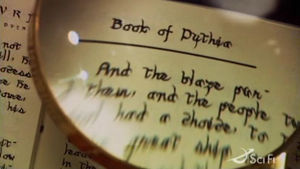
The eternal-return aspect between the peoples of Kobol and Earth suggest a parallel or reverse-origin with humanity as a whole, or the Thirteenth Tribe that presumably populated it. See History of the Twelve Colonies for more analysis.
During the memorial following the escape from Ragnar Anchorage (TRS: "Miniseries, Night 2"), William Adama states, "Life here began out there,[2]" reminding the assembly that this was the first line of the Sacred Scrolls, the principal religious tome of the Colonial faith, told to them by the Lords of Kobol many centuries ago.
Belief
editThe Lords of Kobol
editColonial religion is centered on the Lords of Kobol. In the Re-imagined Series and Caprica, the following Lords of Kobol have been positively identified:
- Zeus – The leader of the Lords. Tom Zarek has twice referred to Bill Adama as "Zeus" ("Bastille Day," "The Farm," as a play on Lee "Apollo" Adama's callsign).
- Aphrodite – The lady of love and sexuality. Kara Thrace prays often to this Lord (TRS: "Flesh and Bone").
- Apollo – Zeus' son, said to be the lord of the hunt and of healing (TRS: "Bastille Day").
- Ares – The lord of war. The infant son of Cally and Galen Tyrol is dedicated to this Lord of Kobol (TRS: "The Resistance, Episode 10"). The Sons of Ares are a militant fundamentalist group, dedicated to Ares (TRS: "Escape Velocity" and "Deadlock")
- Artemis – Twin sister of Apollo, lady of the hunt. Kara Thrace prays often to this Lord (TRS: "Flesh and Bone").
- Asclepius – The lord of healing (TRS: "Escape Velocity").
- Athena – This lord committed suicide "out of despair over the exodus of the thirteen tribes" (TRS: "Home, Part II"). Her tomb holds a map to Earth (TRS: "Kobol's Last Gleaming, Part I").
- Aurora, Goddess of the Dawn (TRS: "Maelstrom")[3].
- Hecate – Shape-changing goddess of the underworld (CAP: "Pilot").
- Hephaestus - Patron god of Canceron.[4]
- Hera – Wife of Zeus. A mountain ridge on Kobol is named after her (TRS: "Home, Part II"), and the first Cylon/human hybrid child is named for this lord (TRS: "Downloaded").
- Hermes - Patron god of Aquaria.[5]
- Hestia - Patron god of Virgon.
- Icarus - Baxter Sarno's joke about the wings of statue of Icarus melting, particularly in the aftermath of the bombing of Clarice Willow's car, is met with scorn (CAP: "Unvanquished").
- Poseidon – Gaius Baltar mentions this deity in a conversation with Tracey Anne (TRS: "He That Believeth in Me"). Deckhand Brooks also prays to this lord. (TRS: "The Face of the Enemy")
- Prometheus - Credited in the pantheon as bringing the gift of fire to mortals, and thus the light of knowledge. Cerebus of the New Cap City nightclub Mysteries retold the story of Prometheus to their patrons, and would pose riddles to patrons regarding this tale (CAP: "Ghosts in the Machine").
The Colonials appear to use multiple names for their lords, interchanging "Mars" for "Ares," "Jupiter" for "Zeus," and so on.[6]
Afterlife
editBelievers think that they will go to Fields of Elysium after death if they led a good life (TRS: "Faith").[7]
Paradise Lost
editAccording to the Sacred Scrolls, the gods once shared a paradise-like existence with the people of Kobol. Later circumstances forced the exodus of the human population of Kobol to the Twelve Colonies and Earth, and lead to Athena's suicide.
The existence of the Lords of Kobol is attested to by the survival of numerous artifacts, including the Arrow of Apollo, the Tomb of Athena and the Gates of Hera. However, although she accepts their historic authenticity, Caprica-Valerii, a Cylon, questions their actual divinity.[8]
The Jealous God
editElosha states that the exodus from Kobol was precipitated when "one jealous god began to desire that he be elevated above all the other gods, and the war on Kobol began." This god was eventually separated from the others.[9] This figure may be related to or identical with "the one whose name cannot be spoken," whose temple is discovered on the algae planet (TRS: "The Eye of Jupiter").
The Path of Olympus
editTom Zarek conveys to Laura Roslin and her followers the news that Commander William Adama had resumed command of Galactica after the attempt on his life by saying: "Zeus has returned to Olympus" (TRS: "The Farm").[10] By Zarek's comment we can infer that Colonial religion appears to acknowledge the existence of a place called Olympus. It cannot yet be determined, however, if Olympus was thought of as the residence of the gods at a specific physical or metaphysical location of Kobol, as there has been no mention of Olympus elsewhere. If Olympus is a metaphysical locale, this may contradict Elosha's comment that the gods and man lived on Kobol together in harmony.[11]
Other Mythological Names in Colonial Culture
editVarious items have been identified which are apparently named after other gods and legendary figures of their faith, although these have not been explicitly identified as Lords of Kobol.
- See main article: Mythological references
The Cycle of Time
edit- Main article: Cycle of Time
"All this has happened before, and all this will happen again."[12]
According to Gaius Baltar, this line from the Pythian prophecy is very well known (TRS: "The Hand of God"). Laura Roslin later expands on it, reminding Kara Thrace,
"If you believe in the gods, then you believe in the cycle of time that we are all playing our parts in a story that is told again, and again, and again throughout eternity" (TRS: "Kobol's Last Gleaming, Part I").
Various events have led some people to believe that they are playing out another turn of this cycle[13]. (See Sacred Scrolls for more detailed analysis).
Sanctity of Life
editAccording to the Sacred Scrolls, abortion is "an abomination in the eyes of the Gods." The more fundamentalist Gemenese strictly adhere to this commandment, however the more secular Colonies such as Caprica apparently do not follow this as strictly: officially, Colonies-wide Federal law guaranteed a woman the right to an abortion, at least at the time of the Fall of the Twelve Colonies (TRS: "The Captain's Hand").
Individual Practice
editThe Colonials display a wide spectrum of religious practice, ranging from Billy Keikeya's atheism (TRS: "Home, Part II," cut scene) to Corporal Venner's literalistic readings of the Sacred Scrolls.
While not fully explained in the Re-imagined Series, it appears, based on the information from a dedication ceremony for Nicholas Tyrol and the prayers of Kara Thrace, that each Colonial is paired, or "placed in the service" with one or more of the Lords. Based on the dedication ceremony blessing, Zeus is a considered "almighty" or foremost of the gods, while other Lords are prayed to by Colonials as a proxy to Zeus.[14]
Artifacts
editDespite Gemenon's fundamentalist climate, the city of Delphi on Caprica was apparently of a mind to store an important religious artifact, the Arrow of Apollo, in a museum, rather than a devotional institution (TRS: "Kobol's Last Gleaming, Part II").
Ancient temples may be also be the repository of special artifacts such as the Eye of Jupiter, believed to be stored inside the legendary Temple of Five ("Rapture," "The Eye of Jupiter").
Confession
editAt least some sects of the Colonial religion practice the concept of absolution of sins through confession. Brothers, and presumably priests as well, may hear confessions as demonstrated by Brother Cavil agreeing to hear Anders' confession (TRS: "The Plan"). It is not known if this practice is uniform throughout the Colonial religion or limited to certain sects.
A confession begins with the confessor saying, "Bless me, Brother, for I have acted against the example of the Gods." The Brother or Priest will then say, "Proceed in the name of the Gods," and after hearing the confession, they will end by saying, "You are absolved in the example of the Gods."
Dress
edit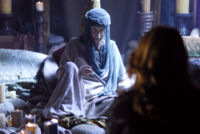
As seen by the various separatists orbiting Kobol (TRS: "Home, Part I"), it appears that many Colonials have clothing that suggests a religious deference. In the scene, one older, white-bearded gentleman is dressed in simple colored robes and a round, flat head covering[15] Other distinctive dress styles of other characters in the scene increase the sense of the dedication of religion in the Gemenese people (which appear to comprise the majority of Roslin's separatists).
The oracle Dodona Selloi dresses in a turban and robes, suggesting a special role in Colonial society or its religious hierarchy (TRS: "Exodus, Part I").
Idols
editKara Thrace, a devotee of Artemis and Aphrodite, prays to them on behalf of Leoben Conoy using figurines that bear a similarity to classic representations of Artemis and Athena. Artemis is depicted with her bow and arrow, and Athena with her helmet of war (TRS: "Flesh and Bone").
When visting the oracle Yolanda Brenn, Thrace receives a figurine of the goddess Aurora as a gift (TRS: "Maelstrom").
Prayer
edit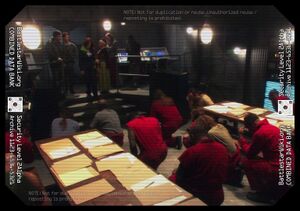
Some former Astral Queen prisoners seeking rehabilitation have turned to group prayer. They greet Laura Roslin as a prophet and she provides them with a blessing (TRS: "The Farm").
Priest Elosha sings a group prayer in a Service for the dead after the Fleet escapes from the initial Cylon attack (TRS: "Miniseries, Night 2").[16] The priest also gives a prayer after Colonial One is boarded by Commander Adama's troops to remove Roslin from power (TRS: "Kobol's Last Gleaming, Part II").
A chaplain delivered a simple prayer at the funeral of Zak Adama, two years prior to the fall of the Colonies (TRS: "Act of Contrition")[17]:
"The burdens of this life are with us but a short time. For Lieutenant Zak Adama, son of William and Carolanne Adama, brother of Lee, the time was too short, but we take comfort in knowing his life was willingly given in service to all of us. We honor them for that. And thus, it falls upon us to repent our sins and with the help of the Lords of Kobol, make our own lives worthy of that gift. And now, we commit his body to the ground from which we were all made."
Corporal Venner asks Laura Roslin to join him in a simple prayer while Galactica is attacked as it desperately tries to find its Fleet (TRS: "Scattered").
(To Roslin:) Will you pray with me? (He begins:) Help us, Lords of Kobol. Help your prophet Laura guide us to the path of righteousness. That we might – that we might destroy our enemies. Let us walk the path of righteousness and lift our faces unto your goodness. Help us turn away from the calls of the wicked and show us the knowledge of your certain salvation. We offer this prayer.
Prayer is also seen in the Season 3 webisode series in a temple (where prayers are written and then burned before an idol), and by Kara Thrace (TRS: "Miniseries" and "Flesh and Bone").
Rosaries
editAs Laura Roslin begins to suffer from chamalla withdrawal in Galactica's brig, Corporal Venner, a Gemenese, anxiously clutches a set of white prayer beads (TRS: "Fragged").
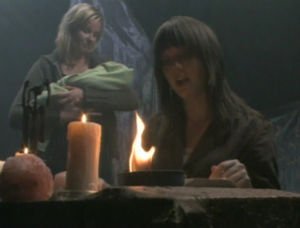
Temples may have been more elaborate places on the Twelve Colonies, but the spaceborne remnants of humanity presumably use any space they can find on their ships to form a basic temple. As seen on New Caprica, a basic temple may consist of a simple altar with candles, idols of the Lords of Kobol, and what meager offerings the Colonials can give as a tithe. Some prayers are written on paper and burned (TRS: "Battlestar Galactica: The Resistance").
The temple on New Caprica was known as the Temple of Artemis (TRS: "Collaborators"), suggesting that temples are dedicated to a Lord or Lords, and may be related to the pairing of Colonials to a specific set of Lords at their dedication ceremony.
A similar arrangement to temple is found in an oracle camp (TRS: "Maelstrom").
A room used for religious services on Galactica is referred to as a temple (TRS: "Escape Velocity"). In the guise of a brother, the Fleet copy of John Cavil establishes a temple aboard Galactica for clandestine meetings with other Cylon agents regarding "the plan" (TRS: "The Plan").
Sagittaron beliefs
editOrthodox Sagittaron beliefs are more anachronistic than the Gemenese's, believing that the mind and body are myths, and that medicine is "an abomination, a sin against the Gods". Sagittarons also blame physicians for the spread of disease due to their ignorance of the aforementioned "myth" of the body and mind. They traditionally do not believe in violence, even to the point of not aiding the New Caprica Resistance in their fight against the Cylon occupation of New Caprica (TRS: "The Woman King").
Other minority beliefs
editA small minority of the Colonials were secretly monothiests. While it is not clear if such worship was still in practice in modern Colonial times up to the Cylon holocaust, an unusual temple found on a remote planet suggests that monotheism was prevalent in the Thirteenth Tribe.
After the Second Exodus, Gaius Baltar later founds a monotheistic cult that finds itself in conflict with the established faiths. Baltar's faith comes into direct, violent conflict with the Sons of Ares as well as the general Colonial polythiests. Mithraism is also noted in practice (TRS: "Escape Velocity")
The Clergy
editThe religious and government bodies of the Twelve Colonies work together. This association is likely based on the religious homogeneity of the Colonies.[18]
Priests/Priestesses
edit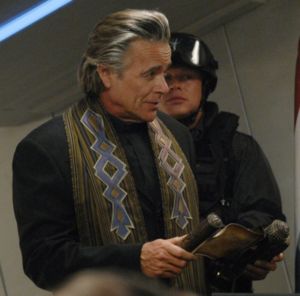
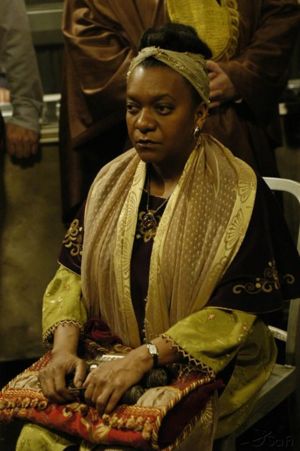
Laura Roslin is sworn into the presidency by a priestess[19], Elosha, who continues on in an advisory capacity within Roslin's administration. Priests also preside over military funerals, without regard for the beliefs of the deceased.
Priests in the Twelve Colonies are apparently not required to practice celibacy, and can be male or female. Chief Galen Tyrol states that his father was a priest and his mother an oracle (TRS: "Resistance" and "Resistance").[20]
According to Billy Keikeya, some priests use chamalla for its hallucinogenic properties. The prescient dreams it imparted to Laura Roslin may imply the use of something similar by Pythia, an ancient prophet. Oracles also use the drug.
Brothers
edit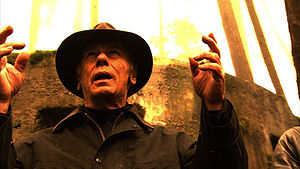
The term Brother is used as a title for male members of the clergy, although it is not fully apparent whether this role is similar to that of a monk or deacon.
As with priests, a brother offers consultation and leads prayer.
The only instance of this clergy is Brother Cavil, who offers guidance to Chief Tyrol.
Cavil, however, is revealed as a humanoid Cylon some time later. Because of Cavil's nature, there may be doubt as to whether Cavil is a useful example of the work of a Brother in Colonial religion.
It is probable that Brothers are lay clergy, unlike priests and oracles, who appear to have political status as well as their religious status.
Sisters
edit
As with Brothers in the clergy, there are Sisters as well.
Sister Tivenan is briefly seen tending to business in the temple on New Caprica, guiding prayer and officiating a dedication ceremony for the newborn son of Galen and Cally Tyrol (TRS: "Battlestar Galactica: The Resistance").
It is probable that Sisters, like Brothers, are lay clergy.
Oracles
edit- Main article: Oracle
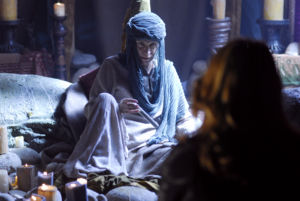

There is little information as to the religious functions of oracles. Dodona Selloi is one of two oracles seen in the Re-imagined Series. She confirms the dreams of a copy of Number Three and the existence of Hera. It is not clear if Selloi is sitting in a tent designated as a temple, but there are numerous ornate or curious inscriptions surrounding and inside her tent that suggest the significance of the oracle's tent or her presence. A second oracle, Yolanda Brenn, gives counsel to Kara Thrace on her strange dreams aboard Galactica (TRS: "Maelstrom").
Priests and oracles may assume their roles due to an personal, possibly inherited affinity to sense spiritual changes or conditions. Galen Tyrol, believed to be the son of a priest and oracle, detects the presence of and finds the Temple of Five alone, based only on his senses, apparently detecting the hidden temple on the otherwise-unremarkable (and undocumented) algae planet (TRS: "The Eye of Jupiter"). However, it is revealed later that he is in fact a humanoid Cylon, one of the (TRS: "Final Five"), and had visited the site before.
A Cylon Connection
edit- Main article: Cylon Religion
- See Also: The Destiny, Final Five, Temple of Five
While humanoid Cylons show a strict, firm belief in a monotheistic God, referring to the Lords of Kobol as "false idols," a connection between the Cylon God and the Lords of Kobol may exist. During the Cylon occupation of New Caprica, an oracle tells Number Three (who has a dream of the oracle's tent and of holding the believed-dead hybrid child Hera") that she has a message from the one that Number Three worships (TRS: "Exodus, Part I"). This poses the question how an oracle of the Lords of Kobol is able to hear the messages of the Cylon God.
The Temple of Five, which a Number Three uses to visualize the identities of the Final Five," was not built for the Cylons (who were not created until 4,000 years later) but for humans. The Temple, according to the Sacred Scrolls, was built for five priests who worshiped "The One Whose Name Cannot Be Spoken". It is not clear if this was the spurned "jealous god" or another fallen member of the Lords of Kobol.[21]
Kara Thrace realizes her destiny, first from the words of a Leoben Conoy model, and later, in a type of dream, through an entity that took the likeness of Leoben, but was not a Cylon. From death, Thrace returns to the Fleet, not as an illusion, but resurrected – something that, prior to Thrace, only a humanoid Cylon could do.
Notes
edit- In a podcast, RDM mentioned that it was intended that there would be many sectarian divisions and religious denominations within colonial society, ranging from a Hellenic-style Cult of Athena to more Buddhist and Hindu forms of worship, and including monotheistic minorities. Mithraism is presumably one such minority belief, similar to the real-life minority Mithraic religion of Roman times. This diversity was not fully shown due to time constraints, but would later be made more apparent in Caprica.
- It seems that Colonial society protects freedom of worship and encourages religious diversity to some degree. However, certain monotheistic organizations such as the Soldiers of the One and the Cult of Baltar are strongly anti-polytheistic, and some devout polytheists such as Jordan Duram take strong exception to the doctrine of monotheism.
- The Tauron funeral rite (CAP: "There is Another Sky") mirrors the Ancient Greek rite of placing a coin on the head of the dead for the Charon, the ferryman who took the souls of the dead across the Rivers Styx and Acheron to The Underworld. The idea of eternal return "all of this has happened before, and will happen again" is strongly present in many forms of Hinduism, which see the universe as cyclical. The use of oracles and icons of deities reflects many historical Indo-European religions from Ancient Greek to Hindu, as well as different shamanistic practices. Additionally the priests of the Lords of Kobol wear different vestments perhaps indicating divisions similar to Protestantism/Catholic/Orthadox in Christianity.
- The use of the names of certain real-life pagan Gods as personal names (like the Germanic Odin) as well as the presence of interchangable Greco-Roman names for the same gods (i.e. Jupiter/Zeus or Mars/Ares) may suggest that the worship of the Lords of Kobol uses different names for the same Gods depending on language. Different colonies may call the same Lords of Kobol names like the Germanic Tyr, Roman Jupiter, Greek Zeus Pater, Indian Deus Pita interchangably. Alternatively, it is possible that some polytheists in the colonies worship a different pantheon altogether, or include the worship of other gods along with the 12 Lords of Kobol, just as how there are Titans and Olympians in Greek religion, Asir and Vanir in Germanic religion, or Devas and Asuras in Hindu religion.
- The punchline of the joke that Tom Zarek tells Margaret "Racetrack" Edmondson as he is escorted from the flight deck in "Blood on the Scales" suggests that pedophilia by priests may have been an issue among the clergy of the Twelve Colonies, similar to anecdotes and allegations involving the Roman Catholic Church.
References
edit- ↑ The Colonial deities are very similar to the Olympic gods of Greek mythology on the real-world Earth.
- ↑ This phrase is a homage to the Original Series, where each episode began with this phrase in a voice-over introduction.
- ↑ Aurora is the Roman counterpart of the Greek Eos. Eos is one of the Titans. Since the Lords of Kobol are modeled after the Twelve Olympians however, this could indicate that she is not one of the Lords, but belongs to another group of deities.
- ↑ In Greek mythology, Hephaestus is known as the god of fire, metalworking, stone masonry, forges and the art of sculpture.
- ↑ In Greek mythology, Hermes is considered the herald (messenger) of the gods, also the protector of humans heralds, travellers, thieves, merchants and orators.
- ↑ Curiously, Laura Roslin mentions that the 134th day of the Cylon occupation of New Caprica is Mars Day (TRS: "Occupation"), suggesting that Ares may also be called by his alternate Roman pantheon's name. The same happens again in "The Passage" when Zeus is referred to by the name of his Roman counterpart Jupiter.
- ↑ This is clearly a direct parallel to the ancient Greek Elysian Fields, the part of the underworld corresponding to "heaven". The visual image of a ferry crossing a river also parallels the river Styx.
- ↑ There is a notion in fan circles that there are twelve lords of Kobol, by analogy to the twelve Cylon models, twelve Colonies, and perhaps the Twelve Olympians of Greek mythology. A post from Ron D. Moore's blog on March 12, 2005 loosely alludes on this coincidence, but further official sourcing has not been revealed.
- ↑ From a deleted scene cut from the episode "Kobol's Last Gleaming, Part I".
- ↑ In Greek mythology, the home of the gods on Earth resided high atop Greece's highest mountain, Mount Olympus, at a time where access to the mountain summit would be almost impossible with the inhabitants' technology of that age.
- ↑ On the other hand, according to the ancient Greek poem Theogony by Hesiod, the gods lived together with humankind until Prometheus' deception at Mecone, after which they dwelt exclusively on mount Olympus and humans exclusively on Earth. Perhaps, then, some transgression caused the Lords of Kobol and humankind to part paths.
- ↑ In a short talk he gave before a screening of "Flesh and Bone," Ron Moore revealed that he "stole" the line from the introduction of the Disney animated version of Peter Pan (lecture part 1 and part 2).
- ↑ The notion of a circular progression of time (also known as eternal return or eternal recurrence) is a common theme in other faiths, particularly Mayan mythology and is a cornerstone of the Hindu and Buddhist faiths. Moreover, Stoic philosophy did believe in the concept of ekpyrosis, the fire which consumes the old world and signals the birth of a new world, identical to the old, for a recurring cycle of birth, death and rebirth.
- ↑ This practice is similar to a Catholic practice of prayer to Mary, mother of Jesus. While Mary is a human, followers believe that, by praying to Mary, she can intercede to aid the acceptance of the prayer by the Trinity, the godhead of the Catholic faith.
- ↑ These robes may remind viewers of the tradition dress of Hasidic Jews, Islamic clerics, or Eastern Orthodox clerics of the real-world Earth.
- ↑ The language she sings is Sanskrit, a classical language of real-world Earth's Hindu/Indian peoples. More about the verses that she sings and their meaning can be found in the Language in the Twelve Colonies article.
- ↑ The prayer's mention of committing a "body to the ground from which we were all made" echoes the Biblical passage of Genesis 3:19:
- "By the sweat of your brow
- you will eat your food
- until you return to the ground,
- since from it you were taken;
- for dust you are
- and to dust you will return."
- ↑ This differs from the United States, whose government is based on religious tolerance through the separation of religious practice and legislature. While the real-world Earth has many, many religions, the Twelve Colonies, as yet, appear to have only one religion and as such does not suffer greatly from schisms or other religious factions, although colonists such as the Gemenese show a different emphasis on how they interpret the religious writings.
- ↑ In "Blood on the Scales," Baltar refers to Elosha as "the Priestess Elosha," indicating that women priests have a femanine title
- ↑ Galen Tyrol's information may be skewed by the revelation that he himself is a Cylon (TRS: "Crossroads, Part II").
- ↑ While the notion of a fallen Lord is speculative in the Re-imagined Series, there is already a parallel series of characters from the Original Series: The Beings of Light and their fallen member, Iblis. Ron D. Moore, however, has stated in several interviews that he was not planning to use this Original Series concept in the Re-imagined Series.






